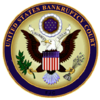- Chapter 13, Title 11, United States Code
-
Bankruptcy in the United States 
Bankruptcy in the United States Authority · History
U.S. Trustee
Court · BAP
Code · FRBPChapters Chapter 7 · Chapter 9 · Chapter 11 · Chapter 12 · Chapter 13 · Chapter 15 Aspects of bankruptcy law Automatic stay · Discharge
Bankruptcy trustee · Claim
Means test · DIP
Employment of Professional PersonsChapter 13, Title 11, United States Code, more commonly known as Chapter 13, is a chapter of the U.S. Bankruptcy Code governing a form of bankruptcy in the United States. Chapter 13 allows individuals to undergo a financial reorganization supervised by a federal bankruptcy court. The Bankruptcy Code anticipates the goal of Chapter 13 as enabling income-receiving debtors a debtor rehabilitation provided they fulfill a court-approved plan. This is in contrast to the goals of Chapter 7 that offers immediate, complete relief of many oppressive debts. It is a form of debt consolidation.
Contents
Choice of chapter
An individual who is badly in debt can file for bankruptcy either under Chapter 7 (liquidation, or straight bankruptcy), under Chapter 13 (reorganization), Chapter 12 (family farmer reorganization), or under Chapter 11.
Debtors may also be forced into bankruptcy by creditors in the case of an involuntary bankruptcy, but only under Chapters 7 or 11. However, in most instances the debtor may choose under which chapter to file. The debtor may also choose to convert to another chapter from a 7 or 11 when forced into an involuntary bankruptcy.
The debtor's financial characteristics and the type of relief sought plays a tremendous role in the choice of chapters. In some cases the debtor simply cannot file under Chapter 13, as he or she lacks the disposable income necessary to fund a viable Chapter 13 plan (see below). Furthermore, Section 109(e) of Title 11, United States Code sets forth debt limits for individuals to be eligible to file under Chapter 13 the debt limits for filing Chapter 13 of unsecured debts of less than $360,475.00 and secured debts of less than $1,081,400.00. These debt limits are subject to annual cost of living increases and represent values updated through April 1, 2010.
Under Chapter 13, the debtor proposes a plan to pay his creditors over a 3- to 5-year period. This written plan details all of the transactions (and their durations) that will occur, and repayment according to the plan must begin within thirty to forty-five days after the case has started. During this period, his creditors cannot attempt to collect on the individual's previously incurred debt except through the bankruptcy court. In general, the individual gets to keep his property, and his creditors end up with less money than they are owed.
Disadvantages
The disadvantage of filing for personal bankruptcy is that, under the Fair Credit Reporting Act, a record of this stays on the individual's credit report for up to 10 years. During the pendency of a Chapter 13 case the debtor is not permitted to obtain additional credit without the permission of the bankruptcy court. Moreover, creditors may not be willing to risk lending money to such an individual. However, this disadvantage is not unique to Chapter 13; it may also apply to individuals currently in a Chapter 11 case, Chapter 12 case or those who are in or have recently been in a Chapter 7 case
Advantages
The advantages of Chapter 13 over Chapter 7 include the ability to: stop foreclosures although a foreclosure would be reinstated upon completion of the bankruptcy; achieve a super discharge of debts of kinds not dischargeable under Chapter 7;[1] value collateral; bifurcate the security interest of creditors in certain property that creditors are either charging too much interest for, or are over-secured, or both, and leading to a cram down modification of the debt; prevent collection activities against non-filing co-signers (co-debtors) during the life of the case.
The Chapter 13 plan
A Chapter 13 plan is a document filed with or shortly after a debtor's Chapter 13 bankruptcy petition.
The plan details the treatment of debts, liens, and the secured status of assets and liabilities owned or owed by the debtor in regard to his bankruptcy petition. In order for plans to take effect, it must meet a number of requirements. These are specified in § 1325 and include:
- providing that unsecured creditors will receive at least as much through the chapter 13 plan as they would in a chapter 7 liquidation
- either not be objected to, repay all creditors in full, or commit all of the debtor's disposable income to the Chapter 13 plan for at least three years (or five years for a debtor who makes an above median income)
External links
References
- ^ The BAPCPA amendments diminished the extent of the super discharge, but discharges under chapter 13 remain broader than those under 7. They include the ability to discharge some tortious damage claims, untimely filed tax claims, marital settlement debts, and some others. See 11 U.S.C. 1328.
Title 11 of the United States Code - Bankruptcy 2007 Filings 2008 Filings 2009 Filings Chapter 7 - Liquidation 413,294 560,015 819,362 Chapter 11 - Business reorganization 5,199 6,971 11,785 Chapter 12 - Family farmers & fishermen 372 343 367 Chapter 13 - Individual reorganization 276,649 334,551 370,875 Categories:- United States bankruptcy legislation
- Chapters of the United States Code
Wikimedia Foundation. 2010.
